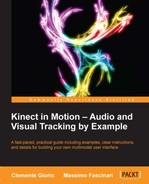In this chapter we introduced Kinect, looking at the key architectural aspects such as the hardware composition and the SDK 1.6 software components. We walked through the color sensor, IR depth sensors, IR emitter, microphone arrays, the tilt motor for changing the Kinect camera angles, and the three-axis accelerometer.
Kinect generates two video streams using the color camera data and the depth information using the depth sensor. Kinect can detect up to six users in its view field and produce a detailed skeleton for two of them. All these characteristics make Kinect an awesome tool for video tracking motion. The Kinect's audio tracking makes the device a remarkable interface for voice recognition. Combining video and audio, Kinect and its SDK 1.6 are an outstanding technology for NUI.
Kinect is not just technology, it is indeed a means of how we can elevate the way users interact with complex software applications and systems. It is a break-through on how we can include NUIs and multimodal interface.
Kinect discloses unlimited opportunities to developers and software architects to design and create modern applications for different industries and lines of business.
The following examples are not meant to be an exhaustive list, but just a starting point that can inspire your creativity and increase your appetite for this technology.
- Healthcare: This improves the physical rehabilitation process by constantly capturing data of the motion and posture of patient. We can enhance this scenario by allowing doctors to check the patient data remotely streamed by the Kinect sensor.
- Education/Professional development: This helps in creating safe and more engaging environments based on gamification where students, teachers, and professionals can exercise activities and knowledge. The level of engagement can be increased even further using augmented reality.
- Retail: This engages customers across multiple channels using the Kinect's multimodal interface. Kinect can be used as a navigation system for virtual windows while shopping online and/or visiting infotainment kiosks.
- Home automation: This is also known as domotics where, thanks to the Kinect audio and video tracking, we can interact with all the electrical devices installed at our home (lights, washing machine, and so on).
In the next chapter, we will start to develop with the Kinect SDK, utilizing the depth and RGB camera streams. The applied examples will enable our application to optimize the way we manage and tune the streams themselves.
